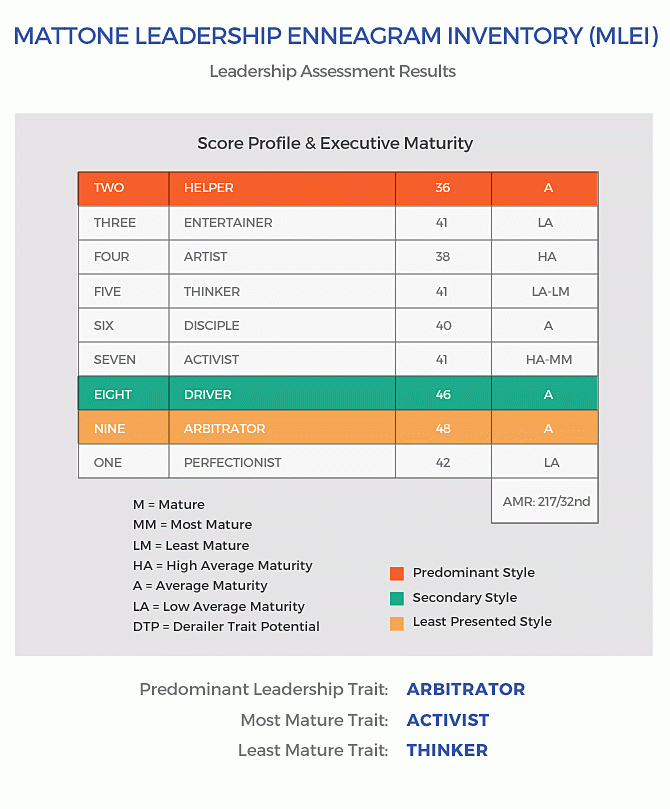THE WORLD’S #1 EXECUTIVE COACHING AND BUSINESS COACHING BLOG SINCE 2017.
What Can the Mattone Leadership Enneagram Inventory do for you?
Published On: January 24, 2025 | Last updated on: March 12, 2025 | Author: John Mattone | Category: Blog
Leaders must balance the art of decision-making with the science of understanding themselves and their teams. This balance is where leadership style becomes critical. The way a leader communicates, inspires, and drives results is deeply influenced by their inner-core strengths—character, values, and self-concept. These inner traits manifest outwardly, shaping their leadership behaviors and ultimately impacting the organization.
Leadership maturity is at the heart of leadership effectiveness. It reflects a leader’s ability to regulate emotions, embrace challenges, and align their inner-core values with outer-core behaviors. A mature leader makes clear decisions, handles adversity gracefully, and inspires trust within their teams.
Conversely, immature leadership—often marked by self-doubt, impulsiveness, or resistance to feedback—can derail individual and organizational success.
This is where the Mattone Leadership Enneagram Inventory (MLEI) can be transformative. Twenty years ago, I developed this assessment tool to help leaders perform a risk assessment of their leadership maturity.

Maturity is what separates great leaders from other leaders.
The MLEI provides insights into a leader’s inner-core strengths and developmental areas, charting a clear path for growth. While many are familiar with the enneagram as a personality framework, the MLEI builds on its foundation, offering leaders a deeper understanding of how their innate tendencies influence their actions and leadership style.
By understanding their leadership style through the lens of the MLEI, they can assess risks, overcome limitations, and foster meaningful growth within their teams and organizations.
Leadership maturity is the cornerstone of intelligent leadership—where purpose and authenticity drive exceptional results.
Crucial Leadership Traits that Drive Organizational Growth
Outstanding leadership is the engine of organizational growth, and the most successful leaders embody a unique combination of traits that align their values with their professional actions.
While no single leadership style guarantees success, there are core traits that elevate leaders and their teams to achieve extraordinary results. Understanding these traits—and how they manifest in various enneagram types—can transform a leader’s approach.
Effective leaders exhibit self-awareness, emotional intelligence, and adaptability. They can navigate complex situations by connecting emotionally with their teams and focusing on the big picture.
However, leaders who become overly involved in operations’ minutiae risk losing sight of strategic priorities, which can stifle creativity and innovation.
The MLEI emphasizes the importance of leadership maturity in cultivating crucial leadership traits. A mature leader integrates strengths across their enneagram type, ensuring their leadership style supports the organization’s goals.
Key traits of successful leaders include:
- Visionary Thinking: The ability to identify ideas with potential and turn them into actionable strategies.
- Emotional Regulation: Managing emotions effectively to inspire trust and confidence, even in high-pressure situations.
- Empathy and Connection: Understanding and addressing the needs of others to build strong, motivated teams.
- Strategic Delegation: Avoiding the trap of becoming overinvested by empowering others to take ownership of tasks.
- Adaptability: Flexibly responding to challenges while aligning with the organization’s mission.
Leaders who fail to embody these traits risk derailing themselves and their organizations.
For example, overly skeptical leaders may miss opportunities for innovation, while those who focus too much on worst-case scenarios can paralyze decision-making.
By honing self-awareness and embracing the strengths of their enneagram type, leaders can refine their leadership style to drive growth, inspire their teams, and ensure that big ideas happen within a culture of trust and accountability.
Understanding the MLEI
MLEI is a powerful tool designed to assess and develop leadership maturity by exploring the intricate connection between inner-core traits and outer-core behaviors. It builds upon the foundational enneagram model, a nine-point system that examines human behavior, motivations, and emotional patterns, to provide actionable insights into leadership effectiveness.
Here’s what makes the MLEI unique:
- Deep Insight into Enneagram Types
The MLEI categorizes leaders into nine enneagram types, each representing a distinct leadership style. Unlike traditional assessments, it highlights how inner motivations shape external leadership behaviors. This understanding equips leaders to align their strengths with their organization’s needs. - Focus on Leadership Maturity
Beyond identifying personality traits, the MLEI evaluates a leader’s maturity level according to their enneagram type. Leadership maturity directly influences how leaders handle challenges, embrace conflict, and drive growth. Immature traits, such as avoiding tough conversations or making overly self-centered decisions, are addressed through targeted development. - Guidance for Personal and Organizational Growth
The MLEI empowers leaders to identify their strengths and blind spots, facilitating a journey of self-awareness and behavioral refinement. Leaders learn to approach difficult discussions constructively, enhancing trust and accountability in their teams.
By offering a deeper understanding of human behavior and its impact on leadership, the MLEI is more than an assessment—it’s a blueprint for transforming leadership potential into lasting impact.
Leaders who leverage this tool can create cultures in which serious discussions lead to meaningful change and individuals and organizations thrive.
The Three Leadership Groups of the MLEI
The Mattone Leadership Enneagram Inventory (MLEI) categorizes leaders into three primary groups: Heart, Head, and Gut leaders. These groups represent distinct ways of addressing challenges, making decisions, and influencing others.
Each group reflects a combination of instincts, emotions, and thought patterns that drive leadership behavior. Understanding these groups helps leaders develop a clear sense of their dominant tendencies while providing a framework to address areas for growth.
1. Heart Leaders: Connection and Compassion
Heart leaders are emotionally driven. They prioritize relationships and the emotional well-being of their teams. Their leadership style often revolves around empathy and collaboration, creating trust and alignment within the organization.
However, without maturity, Heart leaders can become overly involved in personal dynamics or neglect their needs in pursuit of harmony.
2. Head Leaders: Strategy and Analysis
Head leaders approach leadership through logic and planning, often excelling at managing uncertainty with structured, thoughtful decisions. They thrive on clarity and are adept at strategic problem-solving.
Immaturity can lead to overanalysis, self-doubt, or a reluctance to act without perfect information. Head leaders benefit from leveraging their innate strengths while cultivating decisiveness and adaptability.
3. Gut Leaders: Action and Instinct
Gut leaders are action-oriented and instinctual. They tackle challenges with confidence and resilience. They are driven by a sense of urgency and a commitment to results, making them effective in high-pressure situations.
Immature gut leaders may struggle with over-assertiveness or perfectionism, which can hinder collaboration. Developing patience and inclusivity enhances their ability to inspire and unite teams.
Understanding their primary group can help leaders harness their strengths and address vulnerabilities.
This self-awareness is foundational for embracing their unique contributions, refining their leadership style, and effectively guiding their teams toward success.
Exploring the Nine Leadership Styles
The MLEI’s nine leadership styles expand on the three leadership groups, offering a detailed framework for understanding how individual personality types shape leadership behaviors. Each style represents a unique blend of strengths and challenges, providing leaders with insights into their tendencies and a leadership development roadmap.
Heart Leadership Styles: Fostering Connection and Empathy
Heart leaders thrive on emotional connection and team cohesion. When mature, they balance their focus on others with their own needs, creating environments of trust and collaboration.
- Helper: Compassionate and giving; helper leaders excel at supporting others but must ensure they address their needs to avoid burnout.
- Entertainer: Charismatic and driven by success, entertainers inspire through energy and confidence but should temper their need for external validation.
- Artist: Creative and emotionally expressive, artists bring innovation and new ideas to the table but must guard against impracticality or self-absorption.
Head Leadership Styles: Driving Strategy and Innovation
Head leaders excel at navigating complexity and providing clarity in uncertain situations. Maturity helps them act decisively while leveraging their strategic insight.
- Thinker: Analytical and methodical, thinkers tackle challenges with precision but should avoid overthinking or hesitating in decision-making.
- Disciple: Loyal and dependable, disciples provide stability and structure but must work on asserting their independence and voice.
- Activist: Energetic and forward-thinking, activists excel at driving initiatives but should avoid spreading themselves too thin.
Gut Leadership Styles: Leading with Action and Instinct
Gut leaders are decisive and results-oriented, often excelling in high-stakes environments. When mature, they balance their assertiveness with inclusivity and reflection.
- Driver: Bold and goal-oriented, drivers motivate teams to achieve results but should ensure they encourage collaboration.
- Arbitrator: Skilled at resolving conflicts and finding consensus, arbitrators excel at fostering harmony but must learn to confront challenges directly when necessary.
- Perfectionist: Detail-oriented and disciplined, perfectionists deliver exceptional outcomes but should avoid paralyzing themselves and their teams with overly critical standards.
Understanding these nine styles allows leaders to align their natural tendencies with organizational needs.
By raising their leadership maturity, leaders can foster environments that flourish in trust, innovation, and collaboration.

Some leaders are analytical and methodical and can help teams achieve excellent results.
The Psychodynamic Foundation of the Enneagram
The Mattone Leadership Enneagram Inventory is rooted in the psychodynamic principles of human behavior. It offers a profound understanding of how personality type influences leadership effectiveness.
The enneagram’s ancient wisdom provides a lens to explore the underlying motivations, fears, and emotional triggers that shape a leader’s decisions and behaviors. This foundational insight enables leaders to identify and address internal patterns that may limit their growth.
A key aspect of the MLEI is helping leaders cultivate inner compassion, an essential quality for acknowledging vulnerabilities without self-criticism. By embracing their own strengths alongside their development areas, leaders create a balanced sense of self that fosters resilience and adaptability. For instance, a leader with a strong personality type, like the driver, might focus on results at the expense of empathy.
Self-compassion allows them to acknowledge the potential adverse effects of this tendency on the organization’s long-term health. Thus, they can make the necessary changes in their leadership without judgment and create space for meaningful change.
Moreover, the MLEI highlights the interplay between self-awareness and the value of others’ contributions. Effective leadership requires understanding that no individual operates in isolation; instead, success is driven by teams’ combined efforts. Recognizing and appreciating others’ contributions fosters collaboration and creates a culture of trust and shared accountability.
By tapping into the psychodynamic roots of the enneagram, the MLEI helps leaders:
- Identify unconscious patterns that may derail success.
- Leverage their unique strengths while addressing blind spots.
- Build authentic relationships through empathy and mutual respect.
This deep understanding of human behavior supports individual growth and enhances organizational outcomes. Leaders who develop self-acceptance and value others’ contributions can guide their teams with authenticity and wisdom, creating a culture of innovation, trust, and sustained success. Through the MLEI, leaders transform their personality type into a source of strength and inspiration for others.
Transformative Insights: How MLEI Enhances Leadership
MLEI offers transformative insights that help leaders uncover their unique gifts, refine their approach, and guide their teams toward achieving meaningful results. By addressing strengths and developmental areas, the MLEI provides leaders with the tools to lead authentically and purposefully, ensuring they remain focused on their goals while fostering team success.
Unlocking Unique Gifts and Overcoming Struggles
Every leader brings a distinct combination of strengths to the table. These unique gifts enable leaders to inspire others and drive organizational success when fully embraced. For example, a Perfectionist may excel in delivering high-quality results but may struggle with delegating tasks due to their exacting standards. The MLEI helps leaders recognize these tendencies, encouraging them to balance their focus on precision with empowering others to contribute effectively.
Establishing Clear Goals for Maximum Impact
The MLEI emphasizes the importance of setting clear goals to ensure alignment between personal strengths and organizational objectives. Leaders who articulate clear, actionable goals can confidently and clearly guide their teams. A Heart leader like the Helper may instinctively prioritize relationships over structure. Still, with the right coaching, they can learn to align their relational focus with task-oriented strategies, resulting in well-rounded leadership.
Fostering Creativity and Innovation
Creativity is a critical driver of success in modern organizations, and the MLEI supports leaders in cultivating environments where it thrives. For instance, Artists within the Heart group naturally innovate in their roles. By helping these leaders manage their struggles with impracticality, the MLEI ensures that their creativity translates into achievable outcomes.
Through the lens of the MLEI, leaders gain a comprehensive understanding of their strengths, struggles, and the strategies needed to balance both. This allows them to lead confidently, delegate tasks effectively, and inspire their teams to reach new heights of creativity and performance.
How Mattone Enneagram Assessment and Leadership Coaching Helps Organizations Thrive
Leadership impacts every level of an organization, from culture to performance outcomes. MLEI equips leaders to translate personal growth into organizational success. This coaching process enhances individual and collective effectiveness by addressing leaders’ unique strengths and developmental needs.
Transforming Leaders to Transform Organizations
Mattone Intelligent leadership coaching focuses on aligning leaders’ inner and outer core strengths. Leaders learn to:
- Embrace Their Unique Strengths: Recognizing and using their natural talents to drive innovation and results.
- Overcome Barriers: Identifying and addressing tendencies that hinder growth, such as avoiding conflict or hesitating to take risks.
- Enhance Emotional Intelligence: Connecting emotionally with their teams to foster trust and collaboration.
Building a High-Performance Culture
Organizations thrive when leaders model maturity, resilience, and self-awareness. Coaching based on the MLEI helps leaders foster a culture where:
- Feedback is welcomed and used constructively.
- Teams are empowered to take initiative and innovate.
- Conflict is approached as an opportunity for growth, not a threat.
By addressing the specific needs of leaders at different levels, Intelligent Leadership coaching, with the help of MLEI, ensures alignment between leadership growth and organizational objectives. This holistic approach drives measurable results, from increased employee engagement to improved operational performance.
Conclusion: The Path to Becoming a Great Leader
Great leadership begins with self-awareness and a commitment to continuous growth. The Mattone Leadership Enneagram Inventory offers a transformative journey for leaders to unlock their unique gifts, address their vulnerabilities, and lead with maturity and purpose.
As we’ve explored, the MLEI provides a comprehensive framework for:
- Understanding leadership styles and how they align with organizational needs.
- Cultivating leadership maturity through self-reflection, emotional intelligence, and actionable strategies.
- Enhancing team performance by valuing others’ contributions and fostering a culture of trust and innovation.
Leadership is not about perfection—it is about growth. By embracing the insights offered through the MLEI, leaders can refine their focus, set clear goals, and guide their teams toward extraordinary results.
Becoming a great leader is an ongoing journey of self-discovery and development. With the right tools and mindset, leaders can create lasting impact within their organizations and beyond. The opportunity to lead with authenticity and purpose is within reach for those ready to take the first step.
Begin your journey with an MLEI assessment or schedule your free consultation with John Mattone Global today to revolutionize your leadership and drive lasting success.



